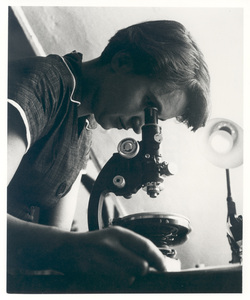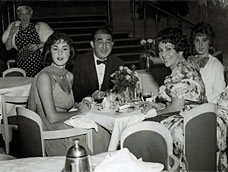 by Yoon Joung Lee A British biophysicist, Rosalind Elsie Franklin, was born in Notting Hill, London in 1920. She is well known for her important contribution to molecular structures, X-ray diffraction, DNA, RNA and viruses. Rosalind was the second one out of five children from an affluent and influential British-Jewish family. She grew up in a very conservative family and her parents believed that girls need an education to get married and they should do charitable social work after marriage. Due to such family’s expectation and belief, Rosalind had some kinds of conflict with her father as she pursued her educations. She excelled with a great talent in Physics and Chemistry while at St. Paul’s Girls’ School in London. She later attended Newnham College, Cambridge, in 1938 and finished her study in 1941 as she was awarded a research scholarship for her work of gas chromatography. In 1942, she started to work on the microstructure of coke at the British Coal Utilization Research Association to work. She received her Doctor of Philosophy (Ph.D) degree from Cambridge in 1945. From 1947 to 1950, she left Cambridge and she went to work with Jacques Mering at the Laboratoire Central des Services Chimiques de L’Etat in Paris to gain experience in X-ray diffraction techniques. There, her work involved the investigation of the changes to carbon fibres when it became graphite on heating. During this time, she published several papers and it became an important part of the work on the physics and chemistry of coal, covered by a current monograph, the annual and other publications. As a result of her contribution and expertise, she got a phone-call from John Randall at King’s College, London. She joined their research group to study DNA fibers using X-ray crystallography. Her responsibility there was determining the structure of DNA. With her knowledge of physical chemistry and controlling the humidity while taking an X-ray photograph, she was able to make thinner fibres, which produce more accurate and easier to interpret X-ray patterns. She also discovered A and B forms of DNA. She focused mainly on A. Although A form showed more X-ray spots, it did not show B form and the helical structure. She started to record her discovery and revised thought in her laboratory notebook. John Randall presented her unpublished current research and data at a routine seminar. Somehow this information was leaked to Watson and Crick. They put all the pieces of the puzzle from various sources including Franklin’s conclusions and data to complete the description of DNA’s structure. Their conclusion for the DNA structure was introduced in the journal Nature in April, 1953. Franklin wrote a supporting article in the same edition. Franklin kept a good friendship with both James Watson and Francis Crick until she finished her work. Her life ended by ovarian cancer in April of 1958. She was 37. After her death, she left a reputation around the world for her great contribution to the structure of carbon compounds and of viruses. However, what made many people sad was that she was not given credit she deserved for her works in the discovery of the structure of DNA.  by Yoon Joung Lee An heiress of the Giant Food and a grandchild of a prominent local Jewish family, Isabelle Scott, was born Fredrica Linda Lehrman in 1940 in Washington DC. She legally changed her name to Isabelle Scott in the late 1990s. Reportedly, her family did not know about her deafness until she was in the second grade. She got various experimental treatments to cure her deafness, but every attempt failed. As Ms. Scott went through this painful challenge, her family’s expectation toward her younger sister Heidi got bigger and her sister soon became the family’s darling. They even named Giant baked goods in her sister’s honor. Heidi later became a Washington’s well-known arts patron and died in 2009. Ms. Scott also had two brothers who still live in the District. While the family’s heavy attention was in her younger sister, Heidi, Ms. Scott started to practice lip-reading. She carefully paid attention and studied very hard to read others’ lips so that she could read what others said without hearing them. Despite her disability, she was an active student at National Cathedral School and wrote for the school’s literary magazine. However, in some ways she lead a double life, as only few knew her own father, Jacob Lehrman, physically and sexually abused her. One day, while she was in her late teens, her boyfriend, Barry Rosenberg, stopped by to see her at her home and saw her face was swollen and bruised. He found it was by her father. An active-duty soldier and a former football player, Rosenberg, confronted Jacob Lehrman and warned him never to do it again. Ms. Scott married Rosenberg in 1959 and had a son, Scott, in 1963. After marriage, she finished her undergraduate study at American University in 1962, and got master’s degrees in medieval history and English literature at University of Maryland in 1965. Then, her family moved to Charlottesville and she finished a PhD in English at the University of Virginia in 1969. After finishing her PhD in the 1970s, she came back to the District and divorced her first husband. While she was teaching English at George Washington and Howard universities, she met a French professor at Howard, Richard Saunders, and married him. However, her second marriage did not last long. In 1982, she met Washingtonian psychotherapist, Douglass Carmichael, and they began an affair. She soon divorced her second husband and married Carmichael in 1983. Marriage with her third husband, Carmichael, did not last long either because he had an affair with another woman. After her third divorce, she went to law school and finished her study at Catholic University in 1992. As a lawyer, she worked for domestic violence cases, directed a domestic violence project, and also lectured on national panels. She also donated $1 million to establish Girl Choristers for students at National Cathedral School where she graduated in 1958. She attended most of the choristers’ concerts or sang at religious services. However, the girls had no idea who she was because she never interacted with the girls. Therefore, the girls were not able to find out about her identity until the day she died, and Ms. Scott was referred as the guardian angel. Also, the girls didn’t know of her identity because those who knew of her donation, kept it secret until her death. A few months before her death, she gave another $3 million to create an endowment and scholarships for the choristers. The reason why she provided this enormous support to the Girl Choristers was that she became devoted to music in the final five years of her life. She dreamt of being a singer as she supported the Girls Choristers. In November 2010, at her age of 70, she died at her home, in the District, of leukemia. |
Archives
July 2017
Categories
All
|
 RSS Feed
RSS Feed